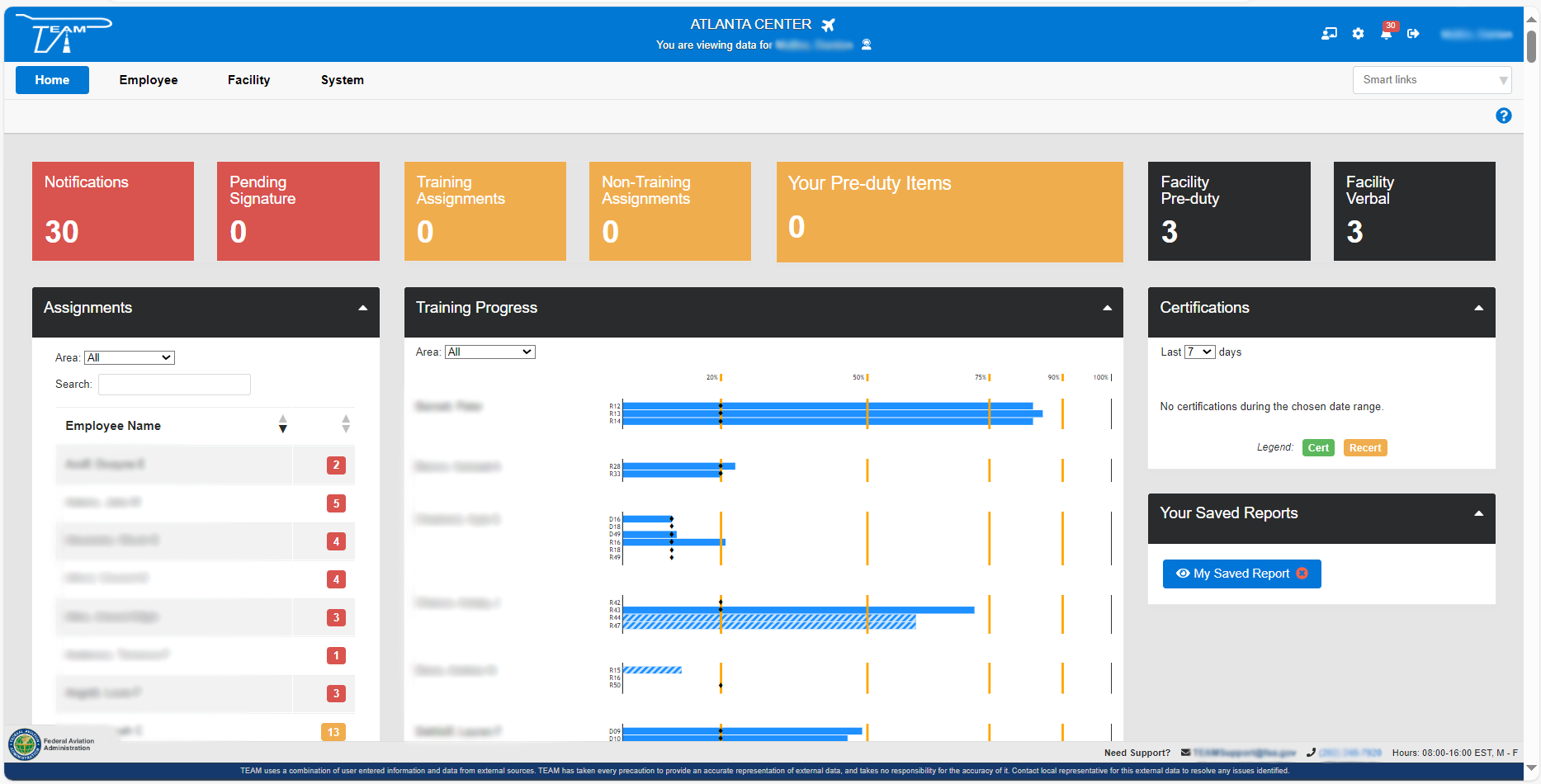
Assisting FAA with TEAM: Modernizing Training with a Unified Platform Powered by Agile Software Development and Data Engineering
Introduction:
Volanno’s Training Enterprise Applications Management (TEAM) project represented a major advancement in FAA air traffic controller training. By shifting from paper records to a cloud-based platform, Volanno improved the accuracy, efficiency, and accessibility of FAA training records. This modernization ensured that controllers are well-prepared to maintain safety and operational excellence across the national airspace.
The ChallengeThe FAA’s outdated, paper-based, and disparate systems for managing air traffic controller training records resulted in delays, inefficiencies, and gaps in training documentation and oversight. Addressing this required a digital transformation to unify records and streamline data management across facilities, along with organizational change management to support the deployment of new, integrated processes.
In Brief:
- Collaborative Approach: Program delivery through an in-house technical team, working closely with FAA management, NATCA, stakeholders, and end-users to achieve successful outcomes with immediate user buy-in, informed by stakeholder and end-user insights.
- Rapid Initial Delivery: Achieved Minimum Viable Product (MVP) deployment in just 6 months, followed by delivery of features with highest business value using an iterative approach.
- Automation and reporting reduced Quality Assurance staff workload for the monthly Training Review Board by over 85%, whereas documentation review previously took 4-5 days, now completed in 4 hours.
- Workflow improvements and automation enabled On-the-Job Training Instructor (OJTI) to electronically complete a training session and achieve 100% capture of OJTI forms—previously a 90-day process, now instantaneous.
- Quick reaction to enhancement requests improved our already exceptional velocity by 30%. Prioritizing requirements, we use the Atlassian Suite (Jira, Confluence, and Bitbucket) for tracking new features, work in progress, and work completed—providing transparency to the FAA on project status.
- Continued enhancement of successful 2023 results, including approximately 1,200 user stories/enhancements, averaging 93 enhancements per month. TEAM’s largest single software delivery included 111 user stories/enhancements, without post-deployment defects.
- Widespread Adoption: The TEAM system serves over 18,000 users, including air traffic controllers, facility managers, and headquarters personnel, across 314 FAA ATC facilities, with expansion to Flight Service Stations underway.
“There was tons and tons of paperwork. Everything went into a pumpkin-colored jacket, an iconic type of standard folder with paper training records for each controller. The FAA has been using this type of folder for nearly 50 years.
I had to enter the same training report data into several computer programs, and it took literally half of my day. This is what it took to communicate with everyone in the FAA who wanted to know what was happening in training.
With the new TEAM system, the same tasks take 45 minutes, leaving more than three hours to do other things such as developing courseware for training classes.” Andrea White - Former Senior Training Advisor at FAA
"TEAM will create consistency throughout every facility as to how training is documented. We have worked to make sure this updated version of TEAM aligns and is compliant with the new Air Traffic Technical Training Order." Scott D. Brown, FAA Policy and Requirements TEAM

The Approach
The TEAM project development required a strategic and multifaceted approach to address the FAA's challenges. Volanno's approach emphasized digital transformation by consolidating the widely varied processes that the FAA facilities use to track air traffic controller training data. TEAM consolidated and improved the functionality of 13 outdated legacy systems into a single, cohesive platform, ensuring consistency and reliability across all FAA training facilities.
Assessment: Volanno began by conducting a comprehensive review of the FAA’s existing business processes and systems to determine the optimal approach for building the new application. This assessment included examining available and approved technologies within the FAA Cloud Services (FCS) to design a robust architecture capable of operating in low-bandwidth environments. To further enhance efficiency, Volanno identified and removed stove-piping and redundancies in data entry by assessing related systems and data interfaces.
Road Map: To guide the system’s development and deployment, Volanno created a detailed road map for systematically rolling out TEAM across the country. Updated with each new build, the road map outlined system functionality and release plans, providing clear milestones for deployment and training. Collaborating with FAA subject matter experts, Volanno documented all requirements for new functionality and enhancements through detailed workflows and process storyboards. These visualizations facilitated accurate and accessible documentation, ensuring all stakeholders remained aligned throughout development.
Cloud Hosting: Volanno transformed TEAM by implementing a cloud-based solution using Amazon Web Services (AWS), enabling secure, scalable, and real-time access to training records. This modernization integrated with the FAA's PIV/MyAccess authentication process, ensuring robust security. Key AWS technologies were deployed to enhance performance and reliability. Volanno pioneered the use of a load balancer in the FAA Cloud Services (FCS), providing application redundancy for uninterrupted access. These innovations eliminated geographical and logistical constraints, improving data accessibility and streamlining record management with efficiency.
Agile Methodology: Volanno employed an Agile Scrum framework to ensure adaptability and responsiveness throughout the development process. With 95% of Volanno's staff trained as Product Owners, Scrum Masters, and Scrum Developers, the team brought extensive expertise to every aspect of Agile implementation. This approach emphasized performance visibility and active stakeholder engagement, enabling the FAA to provide continuous feedback. By leveraging proven Scrum practices, Volanno delivered the first iteration of the system within six months—significantly ahead of the expected industry-standard three-year timeline. This accelerated delivery minimized risks, maximized project success, and set a benchmark for Agile adoption across other FAA teams.
Data Analytics: Volanno deployed integrated data processing and analytical capabilities to transform extensive training datasets from legacy systems and manual processes into a unified, centralized framework. This framework enabled the monitoring of training progress, compliance, and performance trends, equipping administrators with clear, actionable insights. The structured approach to data integration and analysis supported decision-making by delivering reliable, interpretable metrics at scale.
Data Engineering: Volanno designed and implemented data pipelines to manage the seamless capture, transformation, and visualization of training data. Using integrated visualization tools, complex datasets were presented in intuitive formats, allowing FAA administrators to identify trends, monitor outcomes, and address potential issues in a timely manner. The system’s scalable architecture ensured adaptability for future enhancements and data management needs, emphasizing efficient data handling and accessibility.
Training and Training Materials: For seamless deployment of TEAM across FAA facilities, Volanno developed a comprehensive training program and supporting materials. This program includes an 8-hour live webinar tailored for facility-designated super users, who configure the system for operational use and train others. The training incorporates a "train-the-trainer" approach, enabling these key adopters to instruct air traffic controllers, instructors, and managers effectively. To complement the live sessions, Volanno provided instructional guides for each application feature, along with detailed outlines and training scripts, ensuring accessible and reliable resources for all users.
Support: Volanno established a dedicated support system to ensure seamless operations and user satisfaction for the TEAM platform. This system includes both email and phone support around the clock enabling stakeholders to address questions, resolve issues, and log enhancement requests without delay. The support team are intimately trained on the system, platform and functionality.
This approach ensured that the FAA's expectations were upheld at every phase of development. Through strategic planning, innovative technologies, and agile methodology, Volanno delivered the TEAM project on time, within scope, and aligned with the FAA’s long-term goals.
Documentation: Using Agile concepts to build TEAM didn’t just stop at development. Volanno transformed the documentation process for TEAM by replacing the lengthy 50–100-page documentation produced by the legacy systems with short, impactful documents that are theme-based to address the concepts as needed for better accessibility and knowledge transfer.
Improved Efficiency and Focus: FAA trainers and administrators now complete tasks that once took months in just hours, allowing them to focus on higher-value activities, such as enhancing training quality. TEAM's agility in processing records and compliance checks has fundamentally shifted operational focus to areas of greatest impact.
Real-Time Access to Training Records: TEAM's cloud-based architecture provides instant, real-time access to training records, empowering authorized FAA personnel across facilities to make timely, informed decisions. This accessibility eliminates delays, ensures data accuracy, and strengthens inter-departmental coordination.
Drastic Reduction of Time Spent on Routine Tasks: TEAM's streamlined user experience has significantly cut down the time required for routine tasks, as noted by Andrea White, a former air traffic controller: “Tasks that used to take half of my day now take about 45 minutes.” This streamlined workflow allows staff to prioritize essential duties, reflecting a profound shift from 50 years of paper-based processes to a modernized digital environment.
Standardization in Compliance: TEAM’s standardized documentation processes across facilities ensure alignment with the updated Air Traffic Technical Training Order, fostering uniformity and enhancing both trainee and professional controllers’ experiences with a compliant, structured approach.
90 Day Delays to Instantaneous Completion: TEAM’s automated workflows eliminate legacy delays of up to 90 days, enabling on-the-job training signoffs to be completed instantaneously. This advancement ensures timely documentation turnaround.
Data-Driven Actionable Insights into Training Performance and Trends: TEAM’s analytics and data engineering tools empower FAA administrators with insights into training program effectiveness, compliance, and emerging trends. These capabilities enable evidence-based decisions, driving continuous improvement and supporting strategic foresight.
Preparedness for Future Airspace Needs: By equipping FAA personnel for evolving aviation challenges, including eVTOL, drones, and commercial space operations, TEAM supports the NextGen transformation of the national airspace system (NAS) with an info-centric approach designed to meet the demands of decades to come.
Overall, Volanno’s holistic approach to the TEAM project enabled the FAA to improve training management with a reliable, efficient, and user-friendly platform. By integrating advanced technology and agile methods, Volanno fully met FAA requirements, delivering a system that strengthened the FAA’s mission to maintain safety and efficiency across the national airspace. This modernization provides FAA personnel with real-time access to accurate training data, equipping the agency to address future demands in air traffic control with confidence and readiness.



